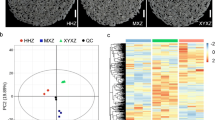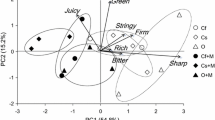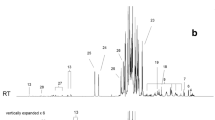Abstract
Sugars and acids of wampee predominantly influence consumer taste preference and its commercial value. The molecular basis of taste variations is currently unknown due to the lack of a large-scale investigation of metabolites in wampee. Here, three tastes cultivars, including YF1 (sweet), YF2 (sweet-sour) and YF3 (sour) wampees with sugar-acid ratios ranging from 1.74 to 26.32, were selected. Then, UPLC-MS/MS based widely targeted metabolome analysis was performed to uncover the molecular mechanism underlying these taste variations, followed by the analysis of KEGG pathways. Results showed that 449, 470, 147 metabolites differed between YF1 vs YF2, YF1 vs YF3, and YF2 vs YF3. Fifty of them were screened as common differential metabolites (DMs) by Venn diagram, including 9 phenolic acids. Among them, the abundance level of methyl 3-O-methyl gallate (M3MG) showed a positive correlation with the titratable acids (R2 = 0.9009) and negative correlation with sugar-acid ratio (R2 = 0.9802) in three cultivars. Therefore, M3MG could be a taste biomarker for wampees. KEGG pathway enrichment analysis also verified that M3MG played a crucial role in the “biosynthesis of amino acids” pathway. These results above provide important insights into the taste-forming mechanism of wampee and will be beneficial for superior eating quality wampee breeding.






Similar content being viewed by others
Data Availability
The datasets generated during the current study are available from the corresponding author on reasonable request.
References
Lim TK (2012) Clausena lansium. Edible medicinal and non-medicinal plants. Springer, Berlin, pp 871–883
Fan YJ, Chen HQ, Mei WL, Kong FD, Li FX, Chen PW, Cai CH, Huang MJ, Dai HF (2018) Nematicidal amide alkaloids from the seeds of Clausena lansium. Fitoterapia. 128:20–25. https://doi.org/10.1016/j.fitote.2018.04.023
Prasad KN, Xie H, Hao J, Yang B, Qiu S, Wei X, Chen F, Jiang Y (2010) Antioxidant and anticancer activities of 8-hydroxypsoralen isolated from wampee [Clausena lansium (Lour.) Skeels] peel. Food Chem 118(1):62–66. https://doi.org/10.1016/j.foodchem.2009.04.073
Li DL, Xing FW (2016) Ethnobotanical study on medicinal plants used by local Hoklos people on Hainan Island, China[J]. J Ethnopharmacol 194:358–368. https://doi.org/10.1016/j.jep.2016.07.050
Shao YZ, Jiang ZT, Zeng JK, Wen L, Dong Y (2020) Effect of ethanol fumigation on pericarp browning associated with phenol metabolism, storage quality, and antioxidant systems of wampee fruit during cold storage[J]. Food Sci Nutr 8(7):3380–3388. https://doi.org/10.1002/fsn3.1617
Tan L, Jin Z, Ge Y, Nadeem H, Cheng Z, Azeem F, Zhan R (2020) Comprehensive ESI-Q TRAP-MS/MS based characterization of metabolome of two mango (Mangifera indica L) cultivars from China. Sci Rep 10(1):20017. https://doi.org/10.1038/s41598-020-75636-y
Chang X, Ye Y, Pan J, Lin Z, Qiu J, Guo X, Lu Y (2018) Comparative assessment of phytochemical profiles and antioxidant activities in selected five varieties of wampee (Clausena lansium) fruits. Int J Food Sci Tech 53(12):2680–2686. https://doi.org/10.1111/ijfs.13877
Chokeprasert P, Charles AL, Sue K, Huang T (2007) Volatile components of the leaves, fruits and seeds of wampee [Clausena lansium (Lour.) Skeels]. J Food Compos Anal 20(1):52–56. https://doi.org/10.1016/j.jfca.2006.07.002
Kong F, Su Z, Guo X, Zeng F, Bi Y (2018) Antidiabetic and lipid-lowering effects of the polyphenol extracts from the leaves of Clausena lansium (Lour.) Skeels on streptozotocin-induced type 2 diabetic rats. J Food Sci 83(1):212–220. https://doi.org/10.1111/1750-3841.14004
Fan R, Peng C, Zhang X, Qiu D, Mao G, Lu Y, Zeng J (2020) A comparative UPLC-Q-Orbitrap-MS untargeted metabolomics investigation of different parts of Clausena lansium (Lour.) Skeels. Food Sci Nutr 8(11):5811–5822. https://doi.org/10.1002/fsn3.1841
Zhang XN, Li X, Su MS, Du JH, Zhou HJ, Li XW, Ye ZW (2020) A comparative UPLC-Q-TOF/MS-based metabolomics approach for distinguishing peach (Prunus persica (L.) Batsch) fruit cultivars with varying antioxidant activity. Food Res Int 137:109531. https://doi.org/10.1016/j.foodres.2020.109531
Girija A, Yadav R, Corke F, Doonan J (2021) Mur LAJ (2021) untargeted metabolomic profiling reveals variation in metabolites associated with nutritional values in Tef accessions[J]. Plant Foods Hum Nutr 76(4):536–539. https://doi.org/10.1007/s11130-021-00931-6
Chen W, Gong L, Guo Z, Wang W, Zhang H, Liu X, Yu S, Xiong L, Luo J (2013) A novel integrated method for large-scale detection, identification, and quantification of widely targeted metabolites: application in the study of rice metabolomics. Mol Plant 6(6):1769–1780. https://doi.org/10.1093/mp/sst080
Ma BQ, Ding YD, Li CY, Li MJ, Ma FW, Yuan YY (2019) Comparative proteomic analysis reveals key proteins linked to the accumulation of soluble sugars and organic acids in the mature fruits of the wild malus species. Plants 8(11):488. https://doi.org/10.3390/plants8110488
Minas IS, Crisosto GM, Holcroft D, Vasilakakis M, Crisosto CH (2013) Postharvest handling of plums (Prunus salicina Lindl.) at 10°C to save energy and preserve fruit quality using an innovative application system of 1-MCP. Postharvest Biol Tec 76:1–9. https://doi.org/10.1016/j.postharvbio.2012.08.013
Gecer MK, Akin M, Gundogdu M, Eyduran SP, Ercisli S, Eyduran E (2016) Organic acids, sugars, phenolic compounds, and some horticultural characteristics of black and white mulberry accessions from eastern Anatolia. Can J Plant Sci 96(1):27–33. https://doi.org/10.1139/cjps-2015-0070
Bett-Garber KL, Lea JM, Watson MA, Grimm CC, Lloyd SW, Beaulieu JC, Stein-Chisholm RE, Andrzejewski BP, Marshall DA (2015) Flavor of fresh blueberry juice and the comparison to amount of sugars, acids, anthocyanidins, and physicochemical measurements. J Food Sci 80(4):S818–S827. https://doi.org/10.1111/1750-3841.12821
Zhang J, Nie J, Li J, Zhang H, Li Y, Saqib F, Syed ASB, Wang J (2020) Evaluation of sugar and organic acid composition and their levels in highbush blueberries from two regions of China. J Integr Agr 19(09):2352–2361. https://doi.org/10.1016/S2095-3119(20)63236-1
Li SH, Wu SL, Li WS (1996) Amides and coumarin from the leaves of Clausena lansium. J Chin Pharm Sci 48:367–373
Habtemariam S (2011) Methyl-3-O-methyl gallate and gallic acid from the leaves of Peltiphyllum peltatum: isolation and comparative antioxidant, prooxidant, and cytotoxic effects in neuronal cells. J Med Food 14(11):1412–1418. https://doi.org/10.1089/jmf.2010.0257
Muir RM, Ibáñez AM, Uratsu SL, Ingham ES, Leslie CA, McGranahan GH, Batra N, Goyal S, Joseph J, Jemmis ED, Dandekar AM (2011) Mechanism of gallic acid biosynthesis in bacteria (Escherichia coli) and walnut (Juglans regia). Plant Mol Biol 75(6):555–565. https://doi.org/10.1007/s11103-011-9739-3
Liang D, Zhu T, Ni Z, Lin L, Tang Y, Wang Z, Wang X, Wang J, Lv X, Xia H, Ezura H (2017) Ascorbic acid metabolism during sweet cherry (Prunus avium) fruit development. PLoS One 12(2):e0172818. https://doi.org/10.1371/journal.pone.0172818
Causse M, Buret M, Robini K, Verschave P (2003) Inheritance of nutritional and sensory quality traits in fresh market tomato and relation to consumer preferences. J Food Sci 68(7):2342–2350. https://doi.org/10.1111/j.1365-2621.2003.tb05770.x
Wheeler GL, Jones MA, Smirnoff N (1998) The biosynthetic pathway of vitamin c in higher plants. Nature. 393(6683):365–369. https://doi.org/10.1038/30728
Kanehisa M, Goto S, Sato Y, Furumichi M, Tanabe M (2011) KEGG for integration and interpretation of large-scale molecular data sets. Nucleic Acids Res 40(D1):D109–D114. https://doi.org/10.1093/nar/gkr988
Funding
This research was funded by Scientific and technical Project of Hainan Province (KYYS-2022-03) and Scientific Research Institute Innovation Project of Hainan Province(jscx202009), China.
Author information
Authors and Affiliations
Contributions
Conceptualization: Qingchun Yin and Hao Deng; Methodology: Hao Deng; Software: Ronghu Zhang; Writing-original draft preparation: Guang Wu and Zhe Chen; All authors have read and agreed to the published version of the manuscript.
Corresponding author
Ethics declarations
Financial Interests
The authors have no relevant financial or non-financial interests to disclose.
Conflict of Interest
The authors declare no conflict of interest.
Additional information
Publisher’s Note
Springer Nature remains neutral with regard to jurisdictional claims in published maps and institutional affiliations.
Rights and permissions
About this article
Cite this article
Yin, Q., Zhang, R., Wu, G. et al. Comparative Metabolomics Analysis Reveals the Taste Variations among Three Selected Wampee Cultivars. Plant Foods Hum Nutr 77, 250–257 (2022). https://doi.org/10.1007/s11130-022-00973-4
Accepted:
Published:
Issue Date:
DOI: https://doi.org/10.1007/s11130-022-00973-4




